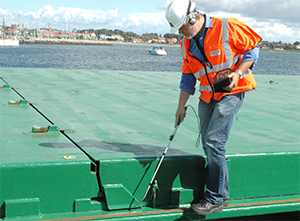A lack of proper servicing of seals can lead to deterioration that can endanger the crew, vessel and cargo. Wrongly applied and poorly maintained cargo hatch covers and sealing systems increase the risk of cargo becoming damaged by water. Leaking or badly maintained hatch covers can lead to consequences more serious than wet cargo such as flooding, accelerated corrosion or even loss of the ship. Proper weather-tightness is a key factor in keeping cargo dry. To ensure that the hatch covers are weathertight, the sealing system needs to be in a good condition. The importance of continually maintaining seal integrity must take a more prominent position in ship maintenance scheduling.
As the main cause of vessel loss is sinking, the maintenance, testing and monitoring of watertight hatches, doors and multiple cable transits is essential. Many mariners may think hatches are robust monolithic structures, thereby failing to appreciate the small tolerances for panel alignment and gasket compression. It is better to think of hatches as complex, finely made structures to be handled with care.
This has been recognized recently by marine insurers. The Swedish Club has released a report warning bulk carrier operators to pay attention to water damage. “Wet Damage on Bulk Carriers,” prepared in cooperation with DNV GL and MacGregor, identifies heavy weather and leaking hatch covers as the most common and the most costly type of wet-damage cargo claim. With the average cost for these claims being almost $110,000, this is alarming.
How have seals been tested traditionally?
Chalk and hose tests for seals are time consuming and sometimes completely impractical.
Chalk testing is used for visual inspection of the compression integrity of doors and hatches on vessels that hold the potential for flooding. Chalk is applied evenly around the knife edge, coaming compression bars or panel cross seams of doorways. The door/hatch is then closed and sealed. Once re-opened, the rubber gasket that pushes against the knife edge is visually inspected. Any breaks in the chalk line indicate a lack of compression in that area. It must be noted that chalk testing is not a leak test, but only provides an indication of potential compression issues.
The International Association of Classification Societies states that a chalk test must be followed by a hose test. This test with pressurized water is used in conjunction to determine the weather-tightness of doors and hatch covers. It should help identify any leakage from the hatch joints, although the exact location of the leakage cannot be pinpointed. This test has various drawbacks:
- The hold must be empty as cargo can be damaged by water. This is not always possible and certainly poses more issues once the ship is laden with goods.
- The test requires drains to be opened, posing a pollution risk.
- Two people are required to effectively carry out the test.
- The test cannot be performed in sub-zero conditions.
- Water pressure and distance can affect results.
- The test is time consuming.
The accuracy of results is subject to human error, and the application of the chalk must be very accurate in order to avoid misdiagnosis. Improper application of chalk could be construed as a compression issue. In addition, these tests conducted at port or in dry dock will never reproduce conditions of the ship at sea and therefore cannot be expected to achieve the same standard.
 |
|
Ultrasonic testing is designed to enhance the ease and accuracy of evaluating ship doors and hatches for watertight, airtight or weather-tight seals. Limitations of chalk and water hose testing have been demonstrated in case studies by The Swedish Club. |
|
Courtesy Public Domain Pictures |
This is demanded by regulations. SOLAS regulation II-1/11.1 states that hatches and watertight seals must be regularly tested: “Where a hose test is not practicable, it may be replaced by an ultrasonic leak test or an equivalent test. In any case, a thorough inspection of the watertight bulkheads shall be carried out.”
In fact, the limitations of chalk and water hose testing have been demonstrated in case studies from The Swedish Club’s recent report.
Case study No. 1
A vessel had loaded wire coils. After loading was complete, the crew taped across the transverse beams of all the cargo holds. The vessel then sailed through heavy weather that lasted for about two days. During this time, the vessel was pitching and rolling heavily. The cargo hatch covers were covered in water. When discharging at the destination port, it was found that the steel coils in the top tiers were corroded. The coils below the center line and folding seams were the most affected.
The surveyor tested the watertight integrity of the cargo hatch covers with an ultrasonic device, which detected significant defects:
- The gaskets were in poor condition.
- The non-return valves were clogged and the ball inside was not moving.
- The transverse packing on the hatch covers was leaking.
- There were some cracked corners and leaking.
- The ventilation covers were leaking.
Case study No. 2
Before loading with grain, the cargo hatch covers had passed a water hose test. Once the vessel was fully loaded, the covers were sealed with tape. The vessel then encountered heavy weather at Beaufort scale 10 with large waves and a swell that covered the hatch covers in water. A visual inspection of the covers, rubber gaskets, securing devices, valves, ventilators and drainage channels found them to be in order, but the tape by the cross joints between the forward and aft hatch panels of two holds had peeled off. A chalk test was carried out and this did not show any imprints on the rubber gaskets.
At the discharge port it was found that part of the top layer of the cargo in a number of the holds was damaged by seawater. Further investigation revealed that there was no contact between the compression bars and rubber gaskets on the cross-joint panels. In addition, an ultrasonic test identified that the cross joints between the forward and aft hatch panels were also leaking.
To prevent damage, The Swedish Club recommends using ultrasound. As stated in its report, “A much more effective method is to use an ultrasonic device, which is designed for this purpose and can pinpoint the area which is leaking and if the compression of the gasket is sufficient. The advantages of using this type of equipment are evident, since ultrasonic tests can be carried out during any stage of the loading without risking cargo damage. The test can also be completed in sub-zero temperatures. The ultrasonic test should be carried out as per the class requirements.”
Dr. Carl Stephen Patrick Hunter is the CEO and managing director of Coltraco Ultrasonics, a British designer and manufacturer of portable and fixed monitoring systems for the naval, shipping, offshore, energy and fire sectors. He is a fellow of the Royal Institution of Naval Architects and the Institute of Marine Engineers, and is a member of the Royal Aeronautical Society, Royal Institute of International Affairs, Royal Society for Asian Affairs and Royal United Services Institute.

